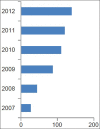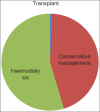Hemodialysis performance and outcomes among end stage renal disease patients from Sokoto, North-Western Nigeria
- PMID: 24701039
- PMCID: PMC3968614
- DOI: 10.4103/0971-4065.127889
Hemodialysis performance and outcomes among end stage renal disease patients from Sokoto, North-Western Nigeria
Abstract
The cost of managing end stage renal disease (ESRD) is prohibitive in Nigeria and the burden is solely borne by patients and their relatives. Despite increasing number of dialysis centers in urban areas, actual utilization of such facilities is very low. It is unclear if the outcomes of these patients have improved in recent times. We evaluated pattern of hemodialysis (HD) performance and outcome among ESRD patients. A 5-year prospective cross-sectional study of all ESRD patients on HD was undertaken. The final outcomes included duration on maintenance dialysis, death from inability to sustain dialysis, absconded, confirmed deaths within or outside health facility or referral for kidney transplant. A total of 540 (54%) of 976 cases of ESRD commenced HD, out of which 7 (1.3%) eventually had live-related kidney transplant in India. The male to female ratio was 2:1 with male and female mean ages of 43 ± 17 and 36 ± 16 years respectively. There was a progressive annual increase in the number of ESRD patients. The commonest underlying renal disorder was chronic glomerulonephritis. The mean HD session duration was 8.11 ± 5.4 hours, while the mean duration of stay on HD was 8.72 ± 1.0 weeks. In conclusion, ESRD is common and is being increasingly recognized. Financial constraint and late presentation are major contributory factors to poor outcomes despite the widespread availability of HD facilities. Therefore, effort should be geared towards aggressive strategies for early detection and treatment. Government commitment in terms of funding and/or subsidy for patient with ESRD is advocated.
Keywords: End stage renal disease; Nigeria; hemodialysis; outcome; performance.
Conflict of interest statement
Figures
References
-
- Levey AS, Coresh J, Balk E, Kausz AT, Levin A, Steffes MW, et al. K/DOQI clinical practice guidelines for CKD: Evaluation, classification and stratification. Am J Kidney Dis. 2002;2:1–246.
-
- Johnson CA, Levey AS, Coresh J, Levin A, Lau J, Eknoyan G. Clinical practice guidelines for chronic kidney disease in adults: Part I. Definition, disease stages, evaluation, treatment, and risk factors. Am Fam Physician. 2004;70:869–76. - PubMed
-
- Ijoma CK, Ulasi II, Kalu AO. Cost implication of treatment of end stage renal disease in Nigeria. J Coll Med. 1998;3:95–6.
-
- Levey AS, Atkins R, Coresh J, Cohen EP, Collins AJ, Eckardt KU, et al. Chronic kidney disease as a global public health problem: Approaches and initiatives – A position statement from kidney disease improving global outcomes. Kidney Int. 2007;72:247–59. - PubMed
LinkOut - more resources
Full Text Sources
Other Literature Sources



